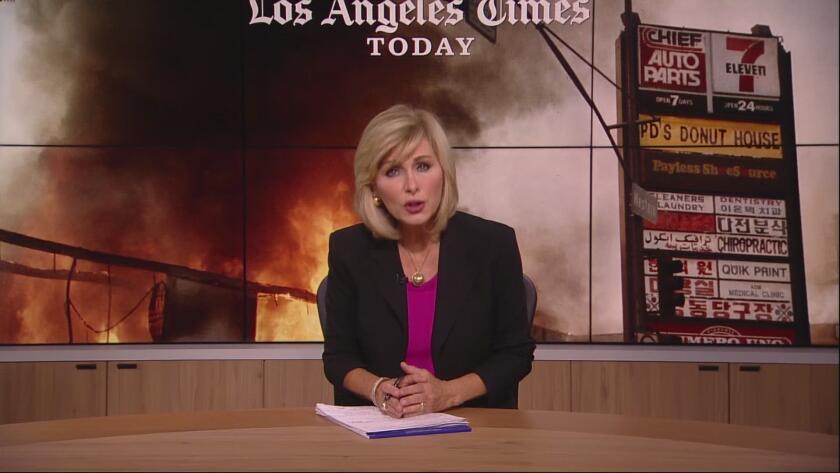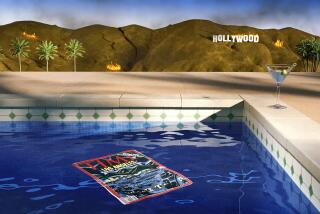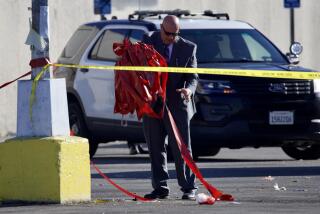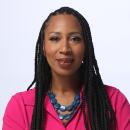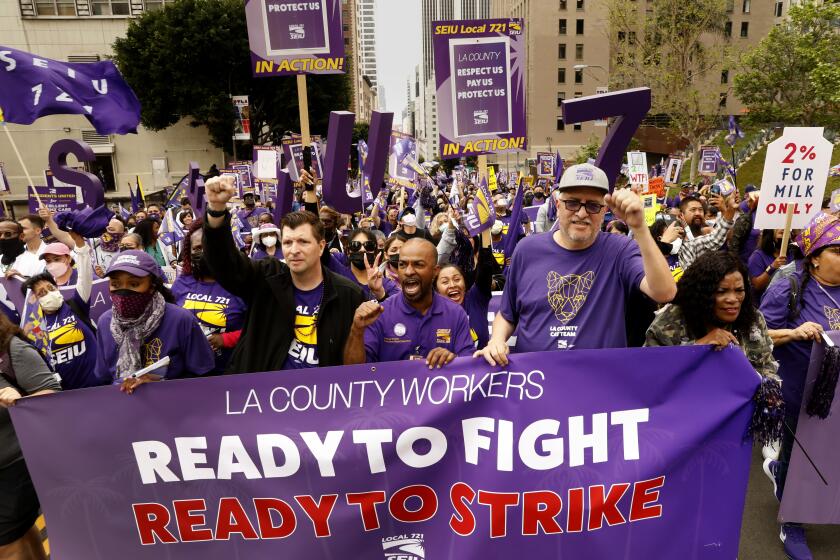South L.A. is largely untouched by unrest. That is by design
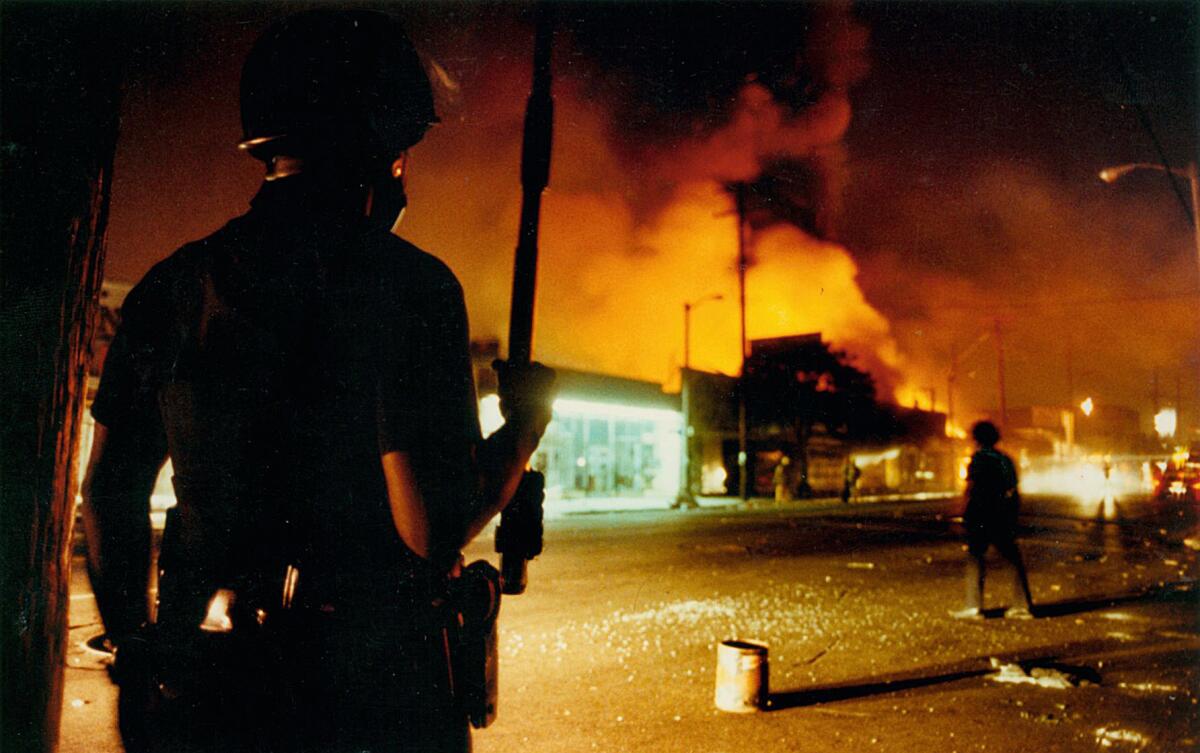
- Share via
In 1992, the last time Angelenos’ rage over police brutality boiled into an uprising, large swaths of South Los Angeles burned to the ground.
Angry mobs took to the street. Some looted shops and torched buildings. Fights broke out in the middle of the chaos. More than 60 people were killed — by police, by other assailants or in accidents related to the unrest.
“It looked like a war zone,” recalled Inglewood resident Yolanda Davidson-Carter. “It was a real riot. People were so angry they couldn’t see straight.”
The violence that occurred after a jury acquitted four white officers in the beating of black motorist Rodney King took decades for South L.A. to recover from, and some say the area has never fully healed. Vacant lots still dot the landscape, a painful reminder.
But this time around, South L.A. has largely been spared, as protests have erupted across the city to condemn the killing by Minneapolis police of George Floyd.
Instead, demonstrators have descended on some of Los Angeles’ most upscale, iconic retail areas, including Beverly Hills, Santa Monica, Hollywood and the Fairfax District. Looting has occurred in some of those locations, as some used the cover of what were largely peaceful protests to rob stores.
Organizers said this geography was deliberate.
“We want to go to places of white affluence so that the pain and outrage that we feel can be put right in their faces,” said Melina Abdullah, one of the leaders of Black Lives Matter.
The group wanted to bring its rage over the Floyd case and so many others to L.A.’s elites, in their own neighborhoods. Its officials said their goal was not to cause looting but to send a message. The impact of that decision became clear Saturday, when images of police cars on fire next to CBS Television City and looting at the Grove shopping mall were broadcast on live television.
Abdullah said this strategy of protesting in affluent communities was adopted early on.
The group was born on a night in July 2013, when protesters gathered in Leimert Plaza Park after George Zimmerman, a neighborhood-watch volunteer, was acquitted in the killing of black Florida teen Trayvon Martin. They waved signs that read “Honk for Trayvon,” and others chanted, “No justice, no peace.”
As they marched out of the plaza, one demonstrator tried to lead the crowd south down Crenshaw Boulevard. Abdullah shouted into her bullhorn to head north toward neighborhoods that were whiter and wealthier.
“That was a lesson from ’92,” she said. “People got it. Everybody knew why we were going north. It didn’t have to be explained.”
LAPD officers had formed a line at Martin Luther King Jr. and Crenshaw boulevards and tried to push the protesters back south. To Abdullah, this confirmed the effectiveness of disrupting the status quo.
- Share via
Metro reporter Angel Jennings discusses the strategy behind BLM protests in wealthy areas with LA Times Today host Lisa McRee.
In the wake of Floyd’s death, other protests across the country seem to be following the same tactics. Demonstrators have marched through retail strips in New York, Chicago and Atlanta in the name of Floyd, a black man who died as former Minneapolis Police Officer Derek Chauvin pressed his knee into Floyd’s neck for nearly nine minutes.
On Friday, Chauvin was arrested and charged with third-degree murder in connection with Floyd’s death. Three other officers who stood by and at times also tried to restrain Floyd have not been charged.
Video of the encounter has been seen by millions and has become a rallying cry, like that of King, whose beating by police was captured on camera and sparked five days of rioting after the officers’ acquittal.
Najee Ali said he can relate to the rage and frustration of the protesters who are acting out now. He was on the streets after the King verdicts were read. He marched to Koreatown and joined others in destroying businesses, in what he described as revenge for the death of Latasha Harlins, a black teen who in 1991 was killed by a Korean shopkeeper over a bottle of orange juice.
Harlins’ death, following closely after the beating of King, contributed to the unleashing of fury in South L.A.’s black communities.
“I went with great pride and joy,” Ali said. “A young child in my neighborhood had been executed ... and [the shopkeeper] didn’t serve any jail time. I had the mindset that by damaging their property, they were getting everything they deserved.”
They smashed windows and spray-painted buildings. He said he watched as others set buildings on fire.
The 1992 riots saw looting and violence across the city, including the mid-Wilshire district, Hollywood and Long Beach. But nowhere was hit as hard as South L.A.
For years, it bore the stigma of the riots. Some businesses never returned. Developers largely avoided building in the area until recent years. And some parcels of land still bear the scars. On Vermont Avenue and Manchester Boulevard, an area the size of four football fields remains vacant 28 years later.
Looking back, Ali said those actions were some of the biggest regrets of his life. This time, he flew to Minneapolis to take part in the peace marches there and to clean up after they devolved into destruction.
Earl Ofari Hutchinson lived through the 1965 Watts riots and the 1992 civil unrest. He said the current protests look vastly different. The earlier events were mostly black people protesting in the streets.
“The current civil unrest looks like a little United Nations, with more whites and other ethnic groups involved in the protests, and even the looting and burning, than blacks,” he said. “The new equation that’s there today but absent in 1965 and 1992 is that young whites are feeling the same rage and willing to speak out, protest, demonstrate and, in some unfortunate cases, destroy out of that rage.”
On social media, residents in some communities where the protests have raged complain of the destruction, the sound of helicopters and sirens and the thick smoke that hangs in the air.
The scene in the Fairfax district left dozens of shops shattered, many of them small businesses. Some merchants — already reeling from coronavirus closures — said they supported the movement but could not understand why they were targeted.
“We’re barely getting over the virus,” said Ricky Flores, whose Melrose Avenue clothing store was looted.
“It hurts so bad. And then to deal with this?”
Crews Monday painted over the words “RIP GEORGE” scribbled in black spray paint on the tower of the Farmers Market. Glass was swept up, and buildings were boarded, awaiting repair.
Elise Levine said she co-owns a commercial property in Van Nuys that was damaged in Monday’s rash of protests. She’s saddened that her tenants, many of them people of color, had goods stolen and property damaged.
Still, the stuff can be replaced, she said. But human life cannot.
“I see the systematic racism and the injustice that has been going on since the 1600s,” she said.
Davidson-Carter, who protested police brutality in 1992, said her Inglewood neighborhood has been quiet and she has to turn on the TV to see what is happening a few miles away.
To her, that’s a problem.
The Inglewood Police Department has long faced allegations of harassing and harming black and Latino people.
Davidson-Carter plans to hold a protest at a nearby park. But when she sent out fliers, the response surprised her: “Why bring the chaos to our neighborhood?”
More to Read
Sign up for Essential California
The most important California stories and recommendations in your inbox every morning.
You may occasionally receive promotional content from the Los Angeles Times.
